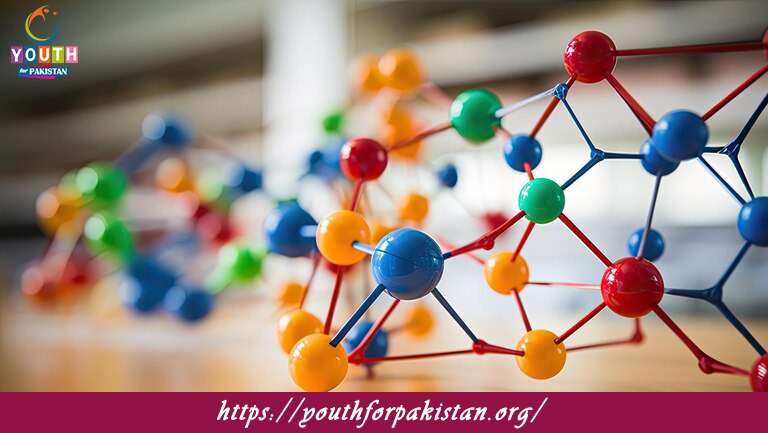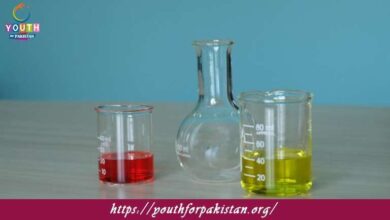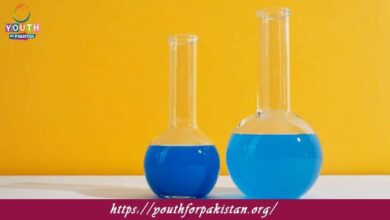12th Class Chemistry Chapter 10 MCQs with Answers

Strengthen your grasp of Alkyl Halides with 12th Class Chemistry Chapter 10 MCQs. Topics include nucleophilic substitution, properties, and synthesis. Incorporating trending terms like alkyl halide quiz, MCQs organic reactions, and chemistry substitution tests, this content ensures optimal preparation.
Alkyl halides are organic compounds that contain:
a) Carbon and nitrogen
b) Carbon and hydrogen
c) Carbon and oxygen
d) Carbon and a halogen element
Which of the following is a common alkyl halide?
a) Methane
b) Ethane
c) Chloroform
d) Benzene
Alkyl halides are derivatives of:
a) Alkanes
b) Alkenes
c) Alkynes
d) Aromatic hydrocarbons
The general formula of alkyl halides is:
a) CnH2n
b) CnH2n+2
c) CnH2n-2
d) CnH2n+1X
Which of the following is an alkyl halide?
a) CH4
b) C2H6
c) CH3Cl
d) C2H4
Alkyl halides are named by replacing the “-ane” suffix of the corresponding alkane with:
a) “-ene”
b) “-yne”
c) “-yl halide”
d) A halogen element name
The alkyl halide “CH3Cl” is named as:
1
a) Methane
b) Ethane
c) Methyl chloride
d) Chloroform
The alkyl halide “CH3CH2Br” is named as:
a) Ethane
b) Ethyl bromide
c) Ethylene bromide
d) Bromoethane
The alkyl halide “CH3CH2CH2I” is named as:
a) Propane
b) Propyl iodide
c) Isopropyl iodide
d) Iodopropane
The alkyl halide “CH3CH(Cl)CH3” is named as:
a) 1-chloropropane
b) 2-chloropropane
c) 1-chlorobutane
d) 2-chlorobutane
The alkyl halide “CH3CH=CHCl” is named as:
a) Chloroethene
b) Chloroethane
c) 1-chloropropene
d) 2-chloropropene
The alkyl halide “CH3CH=CHBr” is named as:
a) Bromoethene
b) Bromoethane
c) 1-bromopropene
d) 2-bromopropene
The alkyl halide “CH3C≡CBr” is named as:
a) Bromoethyne
b) Bromoethane
c) 1-bromopropyne
d) 2-bromopropyne
Alkyl halides can be classified as primary, secondary, or tertiary based on:
a) The number of carbon atoms
b) The type of halogen present
c) The position of the halogen atom on the carbon chain
d) The degree of substitution of the carbon bonded to the halogen
A primary alkyl halide has the halogen atom bonded to a carbon that is:
a) Bonded to one other carbon atom
b) Bonded to two other carbon atoms
c) Bonded to three other carbon atoms
d) Bonded to four other carbon atoms
A secondary alkyl halide has the halogen atom bonded to a carbon that is:
a) Bonded to one other carbon atom
b) Bonded to two other carbon atoms
c) Bonded to three other carbon atoms
d) Bonded to four other carbon atoms
A tertiary alkyl halide has the halogen atom bonded to a carbon that is:
a) Bonded to one other carbon atom
b) Bonded to two other carbon atoms
c) Bonded to three other carbon atoms
d) Bonded to four other carbon atoms
Which of the following is a primary alkyl halide?
a) CH3CH2Cl
b) CH3CHClCH3
c) (CH3)3CCl
d) CH3CH2CH2Cl
Which of the following is a secondary alkyl halide?
a) CH3CH2Cl
b) CH3CHClCH3
c) (CH3)3CCl
d) CH3CH2CH2Cl
Which of the following is a tertiary alkyl halide?
a) CH3CH2Cl
b) CH3CHClCH3
c) (CH3)3CCl
d) CH3CH2CH2Cl
The reaction between an alkyl halide and a hydroxide ion (OH-) is an example of:
a) Substitution
b) Addition
c) Elimination
d) Condensation
The reaction between an alkyl halide and a nucleophile is an example of:
a) Substitution
b) Addition
c) Elimination
d) Condensation
The reaction between an alkyl halide and a metal (e.g., lithium or magnesium) is an example of:
a) Substitution
b) Addition
c) Elimination
d) Condensation
Alkyl halides undergo nucleophilic substitution reactions due to the presence of:
a) A halogen atom
b) A hydroxyl group
c) A carbonyl group
d) A nucleophile
The reaction between an alkyl halide and ammonia (NH3) is an example of:
a) Substitution
b) Addition
4
c) Elimination
d) Condensation
The reaction between an alkyl halide and an alcohol is an example of:
a) Substitution
b) Addition
c) Elimination
d) Condensation
The reaction between an alkyl halide and a Grignard reagent is an example of:
a) Substitution
b) Addition
c) Elimination
d) Condensation
Which of the following alkyl halides is most reactive towards nucleophilic substitution?
a) Primary alkyl halide
b) Secondary alkyl halide
c) Tertiary alkyl halide
d) They have the same reactivity
Which of the following alkyl halides is least reactive towards nucleophilic substitution?
a) Primary alkyl halide
b) Secondary alkyl halide
c) Tertiary alkyl halide
d) They have the same reactivity
Alkyl halides can be converted to alcohols through which reaction?
a) Dehydration
b) Hydrogenation
c) Halogenation
d) Oxidation
The conversion of an alkyl halide to an alcohol involves the replacement of the halogen with a:
a) Hydroxyl group (-OH)
b) Carbonyl group (C=O)
c) Alkene group (C=C)
d) Amine group (-NH2)
The reaction between an alkyl halide and sodium metal (N
a) results in the formation of:
a) An alkane
b) An alkene
c) An alkyne
d) A saturated hydrocarbon
The reaction between an alkyl halide and an amine is an example of:
a) Substitution
b) Addition
c) Elimination
d) Condensation
Which of the following alkyl halides is most likely to undergo elimination reactions?
a) Primary alkyl halide
b) Secondary alkyl halide
c) Tertiary alkyl halide
d) They have the same likelihood of elimination
The reaction between an alkyl halide and a base results in the removal of a:
a) Hydrogen atom
b) Halogen atom
c) Carbon atom
d) Nitrogen atom
The reaction between an alkyl halide and a base is an example of:
a) Substitution
b) Addition
c) Elimination
d) Condensation
Alkyl halides are used in the synthesis of various organic compounds, including:
a) Pharmaceuticals
b) Pesticides
c) Plastics
d) All of the above
The reaction between an alkyl halide and a cyanide ion (CN-) is an example of:
a) Substitution
b) Addition
c) Elimination
d) Condensation
The reaction between an alkyl halide and a thiol (R-SH) is an example of:
a) Substitution
b) Addition
c) Elimination
d) Condensation
The reaction between an alkyl halide and an isocyanide (R-N≡C) is an example of:
a) Substitution
b) Addition
c) Elimination
d) Condensation
Alkyl halides can be prepared by the reaction of an alcohol with:
a) An alkene
b) A halogen acid
c) A carbonyl compound
d) A metal
The reaction between an alkyl halide and a halogen acid results in the formation of:
a) An alkane
b) An alkene
c) An alkyne
d) A haloalkane
Which of the following is an example of a halogen acid?
a) HCl
b) H2SO4
c) HNO3
d) H3PO4
Alkyl halides can be converted back to alcohols through which reaction?
a) Dehydration
b) Hydrogenation
c) Halogenation
d) Reduction
The reaction between an alkyl halide and lithium aluminum hydride (LiAlH4) results in the formation of:
a) An alkane
b) An alkene
c) An alkyne
d) An alcohol
The reaction between an alkyl halide and sodium borohydride (NaBH4) results in the formation of:
a) An alkane
b) An alkene
c) An alkyne
d) An alcohol
Alkyl halides can be converted to ethers through which reaction?
a) Dehydration
b) Hydrogenation
c) Halogenation
d) Williamson ether synthesis
The reaction between an alkyl halide and an alcohol in the presence of a strong base results in the formation of:
a) An alkane
b) An alkene
c) An alkyne
d) An ether
Which of the following is an example of an alkyl halide commonly used as a refrigerant?
a) CH3CH2Cl
b) CH3CH2Br
c) CH3CH2I
d) CH2Cl2
Which of the following is an example of an alkyl halide commonly used as a solvent?
a) CH3CH2Cl
b) CH3CH2Br
c) CH3CH2I
d) CH3CH2F
The reaction between an alkyl halide and a phosphorus compound is an example of:
a) Substitution
b) Addition
c) Elimination
d) Condensation
The reaction between an alkyl halide and a metal (e.g., lithium or magnesium) in the presence of an ether solvent is called:
a) Grignard reaction
b) Friedel-Crafts reaction
c) Wittig reaction
d) Williamson ether synthesis
The reaction between an alkyl halide and a metal (e.g., lithium or magnesium) in the presence of an ether solvent results in the formation of:
a) An alkane
b) An alkene
c) An alkyne
d) An organometallic compound
Alkyl halides are commonly used as intermediates in the synthesis of various organic compounds due to their:
a) High reactivity
b) Low reactivity
c) Stability
d) Non-toxicity
Which of the following alkyl halides is most likely to undergo substitution reactions?
a) Primary alkyl halide
b) Secondary alkyl halide
c) Tertiary alkyl halide
d) They have the same likelihood of substitution
The conversion of an alkyl halide to an alkene involves the removal of a:
a) Hydrogen atom
b) Halogen atom
c) Carbon atom
d) Nitrogen atom
The reaction between an alkyl halide and an amine in the presence of a base is an example of:
a) Substitution
b) Addition
c) Elimination
d) Condensation
Alkyl halides can be converted to alkenes through which reaction?
a) Dehydration
b) Hydrogenation
c) Halogenation
d) Oxidation
The reaction between an alkyl halide and a sulfur compound is an example of:
a) Substitution
b) Addition
c) Elimination
d) Condensation
Alkyl halides are valuable synthetic intermediates and are widely used in various industries, including:
a) Pharmaceuticals
b) Plastics
c) Agriculture
d) All of the above
If you are interested to enhance your knowledge regarding Physics, Chemistry, Biology, and Computer please click on the link of each category, you will be redirected to dedicated website for each category.





